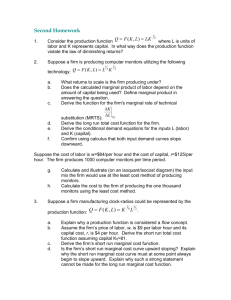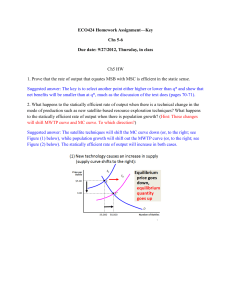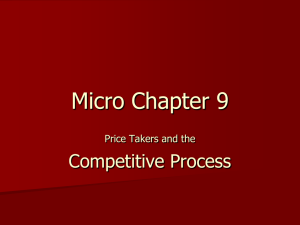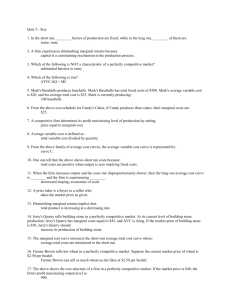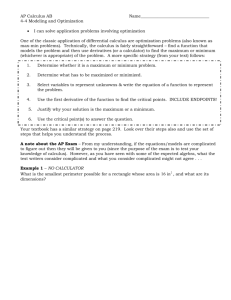Microeconomics I
advertisement
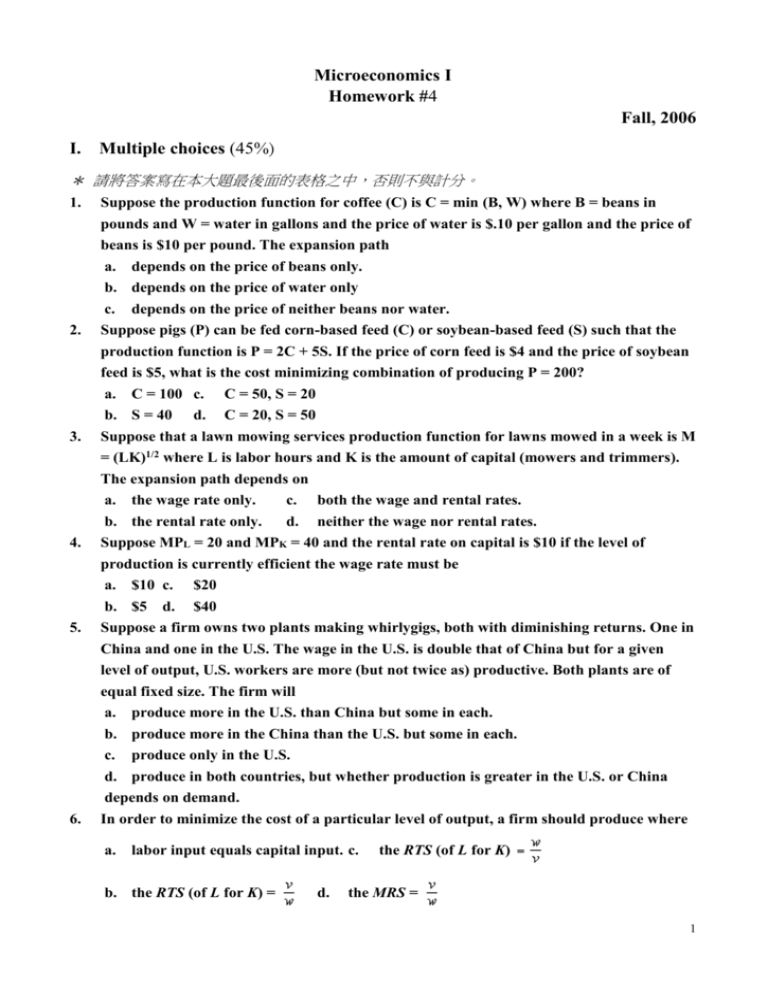
Microeconomics I Homework #4 Fall, 2006 I. Multiple choices (45%) * 請將答案寫在本大題最後面的表格之中,否則不與計分。 1. Suppose the production function for coffee (C) is C = min (B, W) where B = beans in pounds and W = water in gallons and the price of water is $.10 per gallon and the price of beans is $10 per pound. The expansion path a. depends on the price of beans only. b. depends on the price of water only c. depends on the price of neither beans nor water. 2. Suppose pigs (P) can be fed corn-based feed (C) or soybean-based feed (S) such that the production function is P = 2C + 5S. If the price of corn feed is $4 and the price of soybean feed is $5, what is the cost minimizing combination of producing P = 200? a. C = 100 c. C = 50, S = 20 b. S = 40 d. C = 20, S = 50 Suppose that a lawn mowing services production function for lawns mowed in a week is M = (LK)1/2 where L is labor hours and K is the amount of capital (mowers and trimmers). The expansion path depends on a. the wage rate only. c. both the wage and rental rates. 3. 4. 5. 6. b. the rental rate only. d. neither the wage nor rental rates. Suppose MPL = 20 and MPK = 40 and the rental rate on capital is $10 if the level of production is currently efficient the wage rate must be a. $10 c. $20 b. $5 d. $40 Suppose a firm owns two plants making whirlygigs, both with diminishing returns. One in China and one in the U.S. The wage in the U.S. is double that of China but for a given level of output, U.S. workers are more (but not twice as) productive. Both plants are of equal fixed size. The firm will a. produce more in the U.S. than China but some in each. b. produce more in the China than the U.S. but some in each. c. produce only in the U.S. d. produce in both countries, but whether production is greater in the U.S. or China depends on demand. In order to minimize the cost of a particular level of output, a firm should produce where a. labor input equals capital input. c. b. the RTS (of L for K) = d. the RTS (of L for K) the MRS = 1 7. 8. 9. In general, microeconomic theory assumes that firms attempt to maximize the difference between a. total revenue and accounting costs. b. price and marginal cost. c. total revenues and economic costs. d. economic costs and average cost. If demand is inelastic, marginal revenue will be a. positive. c. negative. b. zero. d. constant. If a firm is a price taker, its marginal revenue is a. equal to market price. b. less than market price. c. greater than market price. d. a multiple of market price that may be either greater than or less than one. 10. If the demand faced by a firm is inelastic, selling one more unit of output will a. increase revenues. c. keep revenues constant. b. decrease revenues. d. increase profits. 11. The markup pricing technique involves determining the selling price of a good by adding a profit markup to minimum average cost. This would result in maximum profits only if a. average cost were constant. b. the markup were zero. c. the markup varied with the elasticity of demand. d. demand were inelastic. 12. It is usually assumed that a perfectly competitive firm’s supply curve is given by its marginal cost curve. In order for this to be true, which of the following additional assumptions are necessary? I. That the firm seek to maximize profits. II. That the marginal cost curve be positively sloped. III. That price exceeds average variable cost. IV. That price exceeds average total cost. a. All of the above. d. I and II only. b. I and II but not III and IV. e. I, II and III, but not IV. c. I and III but not II and IV. 13. Which of the following conditions would result in the short run marginal cost curve not correctly reflecting the supply behavior of a profit maximizing firm? a. The firm is a price taker. b. Price exceeds average total cost. c. The elasticity of demand facing the firm is –3. d. the firm can vary several inputs in the short run. 2 14. Suppose a farmer is a price taker in soybeans with cost functions given by TC = .1q2 + 2q + 1000 MC = .2q + 2 Suppose the farmer has to pay a 10% tax on revenue. This has the effect of a. flattening marginal cost. c. decreasing marginal cost. b. increasing marginal revenue. d. decreasing marginal revenue. 15. Suppose a farmer is a price taker in soybeans with cost functions given by TC = .1q2 + 2q + 100 MC = .2q + 2 Suppose the farmer has to pay a 10% tax on revenue. The new profit maximizing level of output is a. unaffected by the tax. c. decreased because of the tax. b. increased because of the tax. 1 2 3 4 5 6 7 8 9 10 11 12 13 14 15 c b c b b c c c a b c e c d c 3 Ⅱ. Problems.(55%) * 答案請寫在題目下面的空白處,並標明題號。(共三題) * 只有答案而無計算過程或理由以及圖形的刻度請標示不清者,一率不予計分。 1. A widget manufacturer has an infinitely substitutable production function of the form q = 2K+L a.) Graph the isoquant maps for q=20, q=40, and q=60. What is the RTS along these isoquants? b.) If the wage rate (w) is $1 and the rental rate on capital (v) is $1, what cost-minimizing combination of K and L will the manufacturer employ for the three different production levels c.) in part a? What is the manufacturer’s expansion path? How would your answer to part b change if v rose to $3 with w remaining at $1? 4 2. Suppose that a firm faces a demand curve that has a constant elasticity of -2. This demand curve is given by q= 256/P2 Suppose also that the firm has a marginal cost curve of the form MC = 0.001q a.) Graph these demand and marginal cost curves. b.) Calculate the marginal revenue curve associated with the demand curve; graph this curve. c.) At what output level does marginal revenue equal marginal cost? 5 A local pizza shop has hired a consultant to help it compete with national chains is the area. Because most business is handled by these national chains, the local shop operates as a price taker. Using historical data on costs, the consultant finds that short-run total costs each day are given by STC=10+q+0.1q2, where q is daily pizza production. The consultant also reports that short-run marginal costs are given by SMC=1+0.2q. a.) What is this price-taking firm’s shot-run supply curve? b.) Does this firm have a shutdown price? That is, what is the lowest price at which the firm will produce any pizza? c.) The pizza consultant calculates this shop’s short-run average costs as SAC= 10/q+1+0.1q And claims that SAC reaches a minimum at q=10. How would you verify this claim without using calculus? d.) The consultant also claims that any price for pizza of less than $3 will cause this shop to lose money. Is the consultant correct? Explain. e.) Currently the price of pizza is low ($2) because one major chain is having a sale. Because this price does not cover average costs, the consultant recommends that this shop cease operations until the sale is over. Would you agree with this recommendation? Explain. 6

